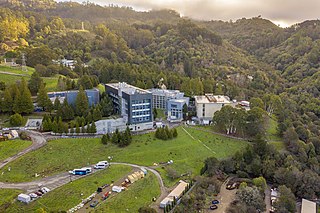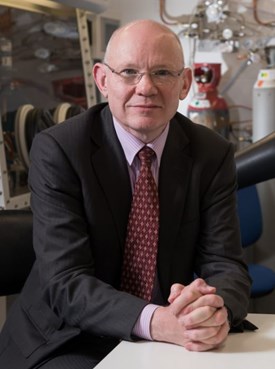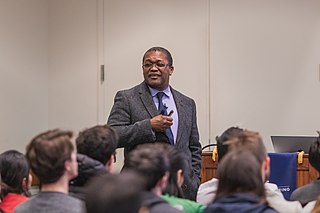
Lawrence Berkeley National Laboratory (LBNL) is a federally funded research and development center in the hills of Berkeley, California, United States. Established in 1931 by the University of California (UC), the laboratory is sponsored by the United States Department of Energy and administered by the UC system. Ernest Lawrence, who won the Nobel prize for inventing the cyclotron, founded the Lab and served as its Director until his death in 1958. Located in the Berkeley Hills, the lab overlooks the campus of the University of California, Berkeley.

John Cromwell Mather is an American astrophysicist, cosmologist and Nobel Prize in Physics laureate for his work on the Cosmic Background Explorer Satellite (COBE) with George Smoot.

Michael Stanley Whittingham is a British-American chemist. He is a professor of chemistry and director of both the Institute for Materials Research and the Materials Science and Engineering program at Binghamton University, State University of New York. He also serves as director of the Northeastern Center for Chemical Energy Storage (NECCES) of the U.S. Department of Energy at Binghamton. He was awarded the Nobel Prize in Chemistry in 2019 alongside Akira Yoshino and John B. Goodenough.
Sossina M. Haile is an American chemist, known for developing the first solid acid fuel cells. She is a professor of materials science and engineering at Northwestern University, Illinois, US.

Sir Peter George Bruce, is a British chemist, and Wolfson Professor of Materials in the Department of Materials at the University of Oxford. In 2018, he was appointed as Physical Secretary and Vice President of the Royal Society. Bruce is a founder and Chief Scientist of the Faraday Institution.
Ramamoorthy Ramesh is an American materials scientist of Indian descent who has contributed to the synthesis, assembly and understanding of complex functional oxides, such as ferroelectric materials. In particular, he has worked on the development of ferroelectric perovskites, manganites with colossal magnetoresistance, and also on multiferroic oxides with potential benefits for modern information technologies.
Gerbrand Ceder is a Belgian–American scientist who is the Daniel M. Tellep Distinguished Professor of Materials Science and Engineering at University of California, Berkeley. He has a joint appointment as a senior faculty scientist in the Materials Sciences Division of Lawrence Berkeley National Laboratory. He is notable for his pioneering research in high-throughput computational materials design, and in the development of novel lithium-ion battery technologies. He is co-founder of the Materials Project, an open-source online database of ab initio calculated material properties, which inspired the Materials Genome Initiative by the Obama administration in 2011. He is also the Founder and CTO of Pellion Technologies, which aims to commercialize magnesium-ion batteries. In 2017 Gerbrand Ceder was elected a member of the National Academy of Engineering, "For the development of practical computational materials design and its application to the improvement of energy storage technology."

Kuzhikalail M. Abraham is an American scientist, a recognized expert on lithium-ion and lithium-ion polymer batteries and is the inventor of the ultrahigh energy density lithium–air battery. Abraham is the principal of E-KEM Sciences in Needham, Massachusetts and a professor at the Northeastern University Center for Renewable Energy Technologies, Northeastern University, in Boston, Massachusetts.
Magnesium batteries are batteries that utilize magnesium cations as the active charge transporting agents in solution and often as the elemental anode of an electrochemical cell. Both non-rechargeable primary cell and rechargeable secondary cell chemistries have been investigated. Magnesium primary cell batteries have been commercialised and have found use as reserve and general use batteries.
Yue Qi is a Chinese-born American nanotechnologist and physicist who specializes in computational materials scientist at Brown University. She won the 1999 Feynman Prize in Nanotechnology for Theory along with William Goddard and Tahir Cagin for "work in modeling the operation of molecular machine designs."

Brent Fultz is an American physicist and materials scientist and one of the world's leading authorities on statistical mechanics, diffraction, and phase transitions in materials. Fultz is the Barbara and Stanley Rawn, Jr. Professor of Applied Physics and Materials Science at the California Institute of Technology. He is known for his research in materials physics and materials chemistry, and for establishing the importance of phonon entropy to the phase stability of materials. Additionally, Fultz oversaw the construction of the wide angular-range chopper spectrometer (ARCS) instrument at the Spallation Neutron Source and has made advances in phonon measuring techniques.
Maximilian Fichtner is professor for Solid State Chemistry at the Ulm University and executive director of the Helmholtz Institute Ulm for Electrochemical Energy Storage (HIU).

George William Crabtree was an American physicist known for his highly cited research on superconducting materials and, since 2012, for his directorship of the Joint Center for Energy Storage Research (JCESR) at Argonne National Laboratory.

Ying Shirley Meng is a Singaporean-American materials scientist and academic. She is a professor at the Pritzker School of Molecular Engineering at the University of Chicago and Argonne Collaborative Center for Energy Storage Science (ACCESS) chief scientist at Argonne National Laboratory. Meng is the author and co-author of more than 200 peer-reviewed journal articles, two book chapter and six patents. She serves on the executive committee for battery division at the Electrochemical Society and she is the Editor-in-Chief for MRS Energy & Sustainability.

Lynden A. Archer is a chemical engineer, Joseph Silbert Dean of Engineering, David Croll Director of the Energy Systems Institute, and professor of chemical engineering at Cornell University. He became a fellow of the American Physical Society in 2007 and was elected into the National Academy of Engineering in 2018. Archer's research covers polymer and hybrid materials and finds applications in energy storage technologies. His h-index is 92 by Google Scholar.

The Materials Project is an open-access database offering material properties to accelerate the development of technology by predicting how new materials–both real and hypothetical–can be used. The project was established in 2011 with an emphasis on battery research, but includes property calculations for many areas of clean energy systems such as photovoltaics, thermoelectric materials, and catalysts. Most of the known 35,000 molecules and over 130,000 inorganic compounds are included in the database.
Ellen K. Cerreta is a materials scientist at Los Alamos National Laboratory, working to provide materials science and technology solutions for national security missions. She is Fellow of ASM International.
Betar Maurkah Gallant is an American engineer who is an associate professor at Massachusetts Institute of Technology. Her research investigates the development of new materials for batteries. She worked with Barack Obama on an educational initiative to train young Americans in clean energy.
Karim Zaghib is an Algerian-Canadian electrochemist and materials scientist known for his contributions to the field of energy storage and conversion. He is currently Professor of Chemical and Materials Engineering at Concordia University. As former director of research at Hydro-Québec, he helped to make it the world’s first company to use lithium iron phosphate in cathodes, and to develop natural graphite and nanotitanate anodes.
Jose L. Mendoza-Cortes is a theoretical condensed matter physicist and material scientist specializing in computational physics, materials science, chemistry, and engineering. His studies include methods for solving Schrödinger's or Dirac's equation, machine learning equations, among others. These methods include the development of computational algorithms and their mathematical properties.










